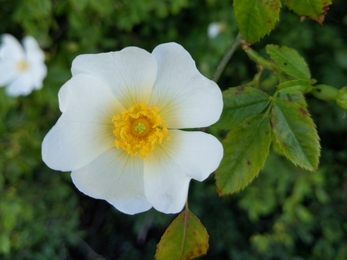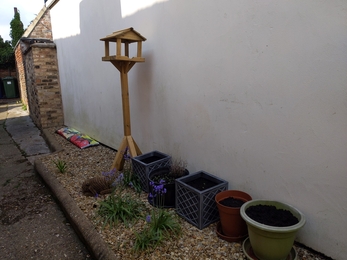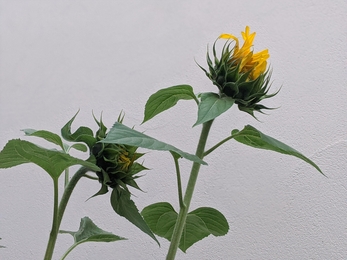The best thing about working from home has been cashing in my commute in exchange for walking time. I have always felt in touch with the seasons, but this year have spent much more time outdoors and noticed many more things as a result, and have got to know local footpaths really well, and now know the local farmer by name (we have bovine-related chats several times a week!). My partner has tolerated my need to take photos everywhere, and I have managed to update my Becca Badger Facebook page with a nature post every day since the end of March. Here are some wildlife-linked positives of spring and summer 2020, with some favourite photos along the way.
The Positives of Lockdown
Hawkweed by Rebecca Neal
Blossom
This year in particular my growing appreciation of blossom started with blackthorn, then wild cherry, crab apple and hawthorn. These trees and bushes always lifted the spirits when walking - and am now photographing their fruits: sloes are very photogenic!
Hedges and verges
With easy access to country footpaths from home it's been great getting to know an area so intimately, seeing it change as the year has progressed, especially in hedgerows and verges. Hearing yellow hammers is a joy (cheese birds after their call which is said to sound like “a little bit of bread and no…cheeeese”) as is learning the song of a lesser white throat. Wild roses - there are several species - brightened the days: goat’s beard, black bryony and white bryony), and bramble patches have been buzzing for months with such a variety of species. Now the ivy flowers are coming out, providing late nectar for insects.
Moths and butterflies
It was very exciting to see my first silver-washed fritillary and white admiral butterflies this year. The fritillaries were manic, it was impossible to follow them, let alone photograph one as it settled for a nanosecond, tantalisingly too far from the path at Brampton Wood Nature Reserve.
Nearer home were several colonies of the nationally scarce small eggar moth caterpillars, which live communally in webbed structures on blackthorn (easily mistaken for caterpillars of the brown-tail moth, which produce hairs that irritate the skin of some people) and wonder how many made it to the final instar (the last moulting stage as a caterpillar). They pupate in late summer and emerge as an adult in late winter/early spring, sometime a few years later.
During 30 Days Wild, we camped out and put out a moth trap (just a bright light that attracts but doesn’t harm them). We saw a favourite, an elephant hawk moth. They are so exotic, rhubarb-coloured; olive green and pink, it is hard to believe they are not from a tropical forest!
A favourite lepidopteran memory was of a common species in a nearby field: numbers had been building for a week or so and walking along the hedge-line saw clouds of hundreds of meadow brown butterflies… magical!
Beetles
I found several longhorn beetles this summer - they're big and obvious - most often black and yellow longhorn, and also saw a weird Stenocorus meridanus and a cool wasp beetle at Woodwalton Fen. Best of all was the scarce Stictoleptura scutellata (Large black longhorn) in Brampton Wood. The puzzle of finding an unfamiliar species and investigating what it might be is fun: posting on our Monitoring and Research Facebook page they confirmed it. This method is great for wildlife records and brings confidence that something correct.
Despite never having seen a stag beetle, (a challenge for next year?) have seen loads of its smaller cousin, the lesser stag beetle, also a dead wood species, and enjoyed spotting devil’s coach horse beetles. There are many on the paths through the wheat and barley fields at the moment in need of a beetle patrol to point them out so they don’t get trodden on!
Wildlife in my yard
My small outdoor space is shared with two other households: a gravel and concrete yard surrounded by walls. Having not had great success with plants last year, this year's resolution was to create something good for wildlife. Assembling a bird table the first guest visited within a few days. Variety has not been huge (great tits, sparrows, blackbird, collard dove and wood pigeon) but it has provided entertainment whilst working from home: a pair of huge wood pigeons are known as the Podge Pidges. Pots were planted with beans, wildflowers, and some supermarket basil, and a lavender which have all done well. The bird table provided some accidental sunflowers, which have grown taller than the highest canes! All the flowers bought bees and hoverflies to the yard; it was amusing to watch a bee trying to hang onto the waving sunflower in high winds…extreme sport for insects!
In an old brick section of wall wildlife has colonised the cracks and crevices: hairy-footed flower bees burrowing into the mortar and their parasite the mourning bee, dancing daddy long legs, zebra spiders, and harvestmen. It really is amazing what can live on bare walls and wouldn't have seen these things if not spending more time at home. With interest piqued, I research more about wildlife gardening, wrote a series of blogs and created a video.
Nature Reserves
Since the end of March, I've not gone more than 40 miles from home, and have sought out new nature reserves, as well as old favourites, visiting 17 Wildlife Trust BCN reserves, seven for the first time, and some Natural England managed reserves..
Exploring Brampton Wood is great with its mix of open grassy rides and cool woody forest (planned closures for this wood later this month check our website for up-to-date information)
Cambourne Nature Reserve is a fantastic reserve for families, and anyone who appreciates accessible paths: the wildflowers were stunning this year - the same at Trumpington Meadows - there were so many butterflies and bees, it was amazing. The view from the top of Crow Hill is nice all year round.
Many families were enjoying Grafham Water reservoir a few weeks ago, part of which is a Wildlife Trust reserve; the well-paved paths which will be less muddy than other reserves; the same also at the Nene Wetlands.
Umbellifers
Umbellifer is another name for members of the carrot family (also known as Apiaceae). Having always loved patterns in nature these flowers are especially pleasing, with their branching heads. I noticed that the more common species of umbellifer flower at slightly different times. Cow parsley first in April, followed by hogweed in May and wild carrot in June. There are many different species in this family, some are poisonous like hemlock.
Nature has provided so many moments over the last few months that have helped us all get through these difficult times; and am grateful that I've been able to get out into the countryside and grateful that the Wildlife Trust BCN exists to stand up for wildlife.
If you have been out photographing more this year, consider entering our photography competition once the 2021 competition opens later in the year.
















































